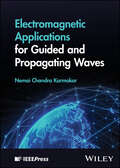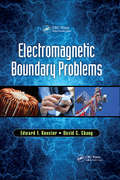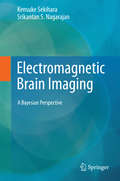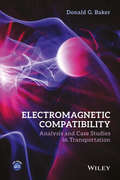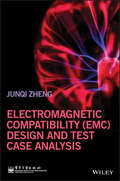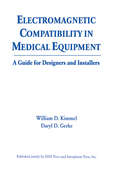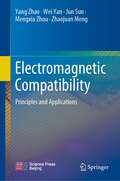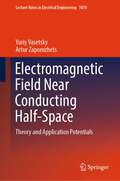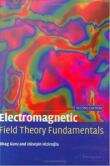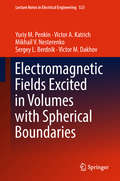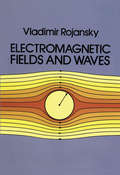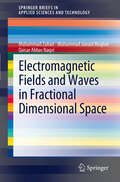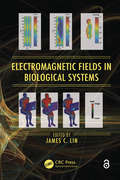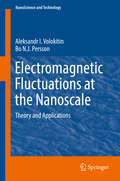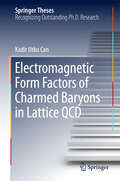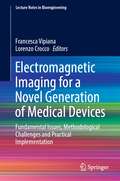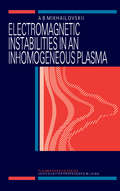- Table View
- List View
Electromagnetic Applications for Guided and Propagating Waves
by Nemai Chandra KarmakarEnables readers to grasp the fundamentals of applied electromagnetics through a blended pedagogical approach Electromagnetic Applications for Guided and Propagating Waves comprehensively covers both fundamentals and advanced topics in applied electromagnetics (EM) for the professional, going above the basic static and dynamic EM field theories that are covered in most undergraduate EM textbooks. The textbook introduces complex topics with illustrations of modern technologies that use the topics, followed by a simple presentation of the basic vector analysis and Maxwell’s equations, supported by many practical examples, math essays, math puzzles, and the most modern technological developments from the websites of prominent technology companies. The textbook includes review questions at the end of each topic to enhance the students’ learning experience and outcomes. It provides the links for multimedia lecture videos and directs students to relevant open sources such as YouTube videos and lecture materials from the prestigious universities of developed and developing nations. The textbook is supported by presentation slides, a solution and instructor’s manual, and MATLAB program downloads. Written by prolific teacher Dr. Karmakar, Electromagnetic Applications for Guided and Propagating Waves discusses topics including: Fundamental theories of resonators, optical waveguides and fibers, antennas and antenna arrays, wireless systems, and electromagnetic compatibility Electrostatic field theory and detailed derivations of electromagnetic fundamentals such as electric charges and Coulomb’s law Applications of time-varying electromagnetic fields, covering transmission lines, impedance matching techniques, and waveguides How electromagnetics has impacted our day-to-day life and how we use it in our workplace and on social media Historical anecdotes and evolution of EM theory from its inception to Maxwell and Hertz Electromagnetic Applications for Guided and Propagating Waves is an essential reference for researchers, professionals, and policy and decision makers in the fields of electromagnetics, electrical engineering, wireless communications, and defense.
Electromagnetic Bandgap (EBG) Structures: Common Mode Filters for High Speed Digital Systems
by Samuel Connor Antonio Orlandi Bruce Archambeault Francesco De PaulisAn essential guide to the background, design, and application of common-mode filtering structures in modern high-speed differential communication links Written by a team of experts in the field, Electromagnetic Bandgap (EBG) Structures explores the practical electromagnetic bandgap based common mode filters for power integrity applications and covers the theoretical and practical design approaches for common mode filtering in high-speed printed circuit boards, especially for boards in high data-rate systems. The authors describe the classic applications of electromagnetic bandgap (EBG) structures and the phenomena of common mode generation in high speed digital boards. The text also explores the fundamental electromagnetic mechanisms of the functioning of planar EBGs and considers the impact of planar EBGs on the digital signal propagation of single ended and differential interconnects routed on top or between EBGs. The authors examine the concept, design, and modeling of EBG common mode filters in their two forms: on-board and removable. They also provide several comparisons between measurement and electromagnetic simulations that validate the proposed EBG filters' design approach. This important resource: • Presents information on planar EBG based common mode filters for high speed differential digital systems • Provides systematic analysis of the fundamental mechanisms of planar EBG structures • Offers detailed design methodology to create EBG filters without the need for repeated full-wave electromagnetic analysis • Demonstrates techniques for use in practical real-world designs Electromagnetic Bandgap (EBG) Structures: Common Mode Filters for High Speed Digital Systems offers an introduction to the background, design, and application of common-mode filtering structures in modern high-speed differential communication links, a critical issue in high-speed and high-performance systems.
Electromagnetic Boundary Problems
by Edward F. Kuester David C. ChangElectromagnetic Boundary Problems introduces the formulation and solution of Maxwell's equations describing electromagnetism. Based on a one-semester graduate-level course taught by the authors, the text covers material parameters, equivalence principles, field and source (stream) potentials, and uniqueness, as well as:Provides analytical solutions
Electromagnetic Brain Imaging
by Kensuke Sekihara Srikantan S. NagarajanThis graduate level textbook provides a coherent introduction to the body of main-stream algorithms used in electromagnetic brain imaging, with specific emphasis on novel Bayesian algorithms. It helps readers to more easily understand literature in biomedical engineering and related fields and be ready to pursue research in either the engineering or the neuroscientific aspects of electromagnetic brain imaging. This textbook will not only appeal to graduate students but all scientists and engineers engaged in research on electromagnetic brain imaging.
Electromagnetic Compatibility
by Donald G. BakerExplains and resolves the electromagnetic compatibility challenges faced by engineers in transportation and communications This book is a mathematically-rich extension of courses required to maintain the Federal Communications Commission (FCC), the Canadian Standards Association (CSA), and the European Union certifications. The text provides an in-depth study of the electromagnetic compatibility (EMC) issues related to specific topics in transportation and communications, including Light Rail Transit, shadow effects, and radio dead spots, through the analysis of real-world case studies in the United States and Europe. The author provides Cartesian, cylindrical, and spherical solutions that can be applied to Maxwell's and Wave Equations. The book covers topics such as SCADA Systems, shielding, and complexities of radio frequencies and their effect on communication houses. The author also provides information for alternative industries to apply the solutions from the case studies and background content to their own professions. Presents a series of over twenty real-world case studies related to EMC in transportation and communications Covers power line radiation, shadow effects on subway cars, train control systems, and edge distortions Includes the OATS testing method and Department of Transportation (DOT) test Provides access to a companion website housing power point slides and additional appendices Electromagnetic Compatibility: Analysis and Case Studies in Transportation is a reference for practicing engineers involved in transportation and communications, as well as post-graduate engineering students studying transportation and communications in engineering.
Electromagnetic Compatibility (EMC) Design and Test Case Analysis
by Junqi ZhengA practical introduction to techniques for the design of electronic products from the Electromagnetic compatibility (EMC) perspective Introduces techniques for the design of electronic products from the EMC aspects Covers normalized EMC requirements and design principles to assure product compatibility Describes the main topics for the control of electromagnetic interferences and recommends design improvements to meet international standards requirements (FCC, EU EMC directive, Radio acts, etc.) Well organized in a logical sequence which starts from basic knowledge and continues through the various aspects required for compliance with EMC requirements Includes practical examples and case studies to illustrate design features and troubleshooting Author is the founder of the EMC design risk evaluation approach and this book presents many years’ experience in teaching and researching the topic
Electromagnetic Compatibility in Medical Equipment: A Guide for Designers and Installers
by William D. Kimmel Daryl GerkeCo-published with the IEEE Press, this book is a practical, hands-on guide to EMC issues for medical device designers and installers. It addresses electromagnetic interference and covers the basics of EMC design, physics, and installation, minimizing theory and concentrating upon the correct way to ground and shield. Covering EMC from the inside out, the book provides the basics of electronics, discusses and evaluates problems and common causes, and explores effective remedial techniques at three levels: circuit, box, and interconnect. It contains appendices that provide important reference material such as constants and conversion factors.
Electromagnetic Compatibility: Principles and Applications
by Yang Zhao Wei Yan Jun Sun Mengxia Zhou Zhaojuan MengThis book highlights principles and applications of electromagnetic compatibility (EMC). After introducing the basic concepts, research progress, standardizations and limitations of EMC, the book puts emphasis on presenting the generation mechanisms and suppression principles of conducted electromagnetic interference (EMI) noise, radiated EMI noise, and electromagnetic susceptibility (EMS) problems such as electrostatic discharge (ESD), electric fast transient (EFT) and surge. By showing EMC case studies and solved examples, the book provides effective solutions to practical engineering problems. Students and researchers will be able to use the book as practical reference for EMC-related measurements and problem- solution.
Electromagnetic Computation Methods for Lightning Surge Protection Studies (Wiley - IEEE)
by Vladimir A. Rakov Yoshihiro BabaPresents current research into electromagnetic computation theories with particular emphasis on Finite-Difference Time-Domain Method This book is the first to consolidate current research and to examine the theories of electromagnetic computation methods in relation to lightning surge protection. The authors introduce and compare existing electromagnetic computation methods such as the method of moments (MOM), the partial element equivalent circuit (PEEC), the finite element method (FEM), the transmission-line modeling (TLM) method, and the finite-difference time-domain (FDTD) method. The application of FDTD method to lightning protection studies is a topic that has matured through many practical applications in the past decade, and the authors explain the derivation of Maxwell’s equations required by the FDTD, and modeling of various electrical components needed in computing lightning electromagnetic fields and surges with the FDTD method. The book describes the application of FDTD method to current and emerging problems of lightning surge protection of continuously more complex installations, particularly in critical infrastructures of energy and information, such as overhead power lines, air-insulated sub-stations, wind turbine generator towers and telecommunication towers. Both authors are internationally recognized experts in the area of lightning study and this is the first book to present current research in lightning surge protection Examines in detail why lightning surges occur and what can be done to protect against them Includes theories of electromagnetic computation methods and many examples of their application Accompanied by a sample printed program based on the finite-difference time-domain (FDTD) method written in C++ program
Electromagnetic Distance Measurement
by International Association of GeodesyElectromagnetic distance measurement, by using light and microwaves for direct linear measurements and thus circumventing the need for traditional methods of triangulation, may well introduce a new era in surveying. This book brings together the work of forty-eight geodesists from twenty-five countries. They discuss various new EDM instruments—among them the Tellurometer, Geodimeter, and air- and satellite-borne systems—and investigate the complex sources of error. The book is therefore a unique and comprehensive source on the subject. UNESCO and R.I.C.S. have assisted financially in its production.
Electromagnetic Field Near Conducting Half-Space: Theory and Application Potentials (Lecture Notes in Electrical Engineering #1070)
by Artur Zaporozhets Yuriy VasetskyThe book is devoted to the solution of one general problem of the theory of a three-dimensional quasi-stationary sinusoidal and pulse electromagnetic field. These studies, unlike many well-known works, are based on obtained exact analytical solution of the problem for the field, generated by external current sources near the conducting body with plane surface. The solution for the vector and scalar potentials, electric and magnetic intensities in the dielectric and conducting media is found without restrictions on the configuration of current sources,properties of the media and field frequency. Some general properties of field formation for arbitrary field in the considered system are obtained (in particular, full compensation by the field of the electric charge distributed on the interface between the media, the normal component of the induced external electric field and, accordingly, the equality to zero the components both of the current density and the electric field intensity perpendicular to the interface; the non-uniform electromagnetic field decreases in depth of conducting medium faster than uniform field). It is shown that the exact analytical solution depends on the values of the parameter proportional to the ratio of the field penetration depth to the distance between the external field sources and the body. The concept of strong skin effect is extended to the case of small value of the introduced parameter. A significant simplification of theexpressions was obtained as an asymptotic expansion on this small parameter. In the case of pulsed fields approximate method gives the highest accuracy during important initial period of pulse time. For asymptotic expansion the approximate impedance boundary condition is generalized to the diffusion of non-uniform field into conducting medium. The book is intended for the researchers, postgraduate students and students specialized in theory and calculations of electromagnetic fields.
Electromagnetic Field Theory Fundamentals
by Bhag Singh Guru Hüseyin R. HiziroğluGuru and Hiziroglu have produced an accessible and user-friendly text on electromagnetics that will appeal to both students and professors teaching this course. This lively book includes many worked examples and problems in every chapter, as well as chapter summaries and background revision material where appropriate. The book introduces undergraduate students to the basic concepts of electrostatic and magnetostatic fields, before moving on to cover Maxwell's equations, propagation, transmission and radiation. Chapters on the Finite Element and Finite Difference method, and a detailed appendix on the Smith chart are additional enhancements. MathCad code for many examples in the book and a comprehensive solutions set are available at www. cambridge. org/0521830168.
Electromagnetic Fields Excited in Volumes with Spherical Boundaries (Lecture Notes In Electrical Engineering #523)
by Victor A. Katrich Yuriy M. Penkin Sergey L. Berdnik Mikhail V. Nesterenko Victor M. DakhovThis book discusses the problem of electromagnetic wave excitation in spatial regions with spherical boundaries and the accurate mathematical modeling based on numerical and analytical methods to significantly reduce the time required for developing new antenna devices. It particularly focuses on elements and systems on mobile objects of complex shape that are made of new technological materials. The experimental development of such devices and systems is an extremely time-consuming, lengthy, and expensive process. The book is intended for senior and postgraduate students and researchers working in the fields of radiophysics, radio engineering and antenna design. The authors assume that readers understand the basics of vector and tensor analysis, as well as the general theory of electrodynamics. The original results presented can be directly used in the development of spherical antennas and antenna systems for the mobile objects. The book addresses problems concerning the construction of Green’s functions for Hertz potentials in electrodynamic volumes with spherical boundaries, and solves these clearly and concisely. It also uses specific examples to analyze areas where the results could potentially be applied. The book covers the following topics: · excitation of electromagnetic fields in coordinate electrodynamic volumes; · Green’s functions for spherical resonators; · Green’s functions for infinite space outside of spherical scatterers; · electromagnetic fields of dipole radiators on spherical scatterers; · electromagnetic fields of thin radial impedance vibrators on perfectly conducting spheres; · electrodynamic characteristics of narrow slots in spherical surfaces; · multi-element and combined vibrator-slot radiators on spherical surfaces.
Electromagnetic Fields and Interactions (Dover Books On Physics Series)
by Richard BeckerFor more than a century, "Becker" and its forerunner, "Abraham-Becker," have served as the bible of electromagnetic theory for countless students. This definitive translation of the physics classic features both volumes of the original text.Volume I, on electromagnetic theory, includes an introduction to vector and tensor calculus, the electrostatic field, electric current and the field, and the theory of relativity. The second volume comprises a self-contained introduction to quantum theory that covers the classical principles of electron theory and quantum mechanics, problems involving one and several electrons, radiation theory, and the relativistic theory of the electron. Based on research by the great Harvard science historian Gerald Holton, this book clearly explains Maxwell's and Dirac's field equations and contains a profound discussion and elegant use of the Helmholtz theorem on vector fields. Problems with solutions appear throughout the text, which is illuminated by 148 illustrations.
Electromagnetic Fields and Waves
by Vladimir RojanskyIntended for advanced undergraduate and graduate students, this well-known and popular textbook provides an introduction to the physical principles, mathematical apparatus, and typical applications of classical electromagnetic theory. Beginning with the notion of scalar fields, Professor Rojansky leads the student through vectors and vector fields, the laws of Ohm, Joule, Coulomb, and Faraday, static electricity, and continues all the way to Maxwell's equations for bodies at rest, and to examples of electromagnetic waves. A particularly useful feature of the book is the author's introduction and explanation of the necessary mathematics as he goes along, rather than presuming student understanding. Although an extensive background is not necessary, a general knowledge of physics and calculus is a prerequisite. Throughout the book, the development of each topic is explicit and unhurried, an approach intended to avoid basic misconceptions that lead to major misunderstandings later on. Short exercises help the student test his grasp of the material, and the text is studded with diagrams and illustrations that supplement the content and elucidate many hard-to-visualize concepts. The book ends at a point where the use of Maxwell's equations in several important problems has been illustrated, and students are prepared to proceed to a variety of further topics. Professor Rojansky brings many years of experience both as a teacher and a scientist (including ten years of advanced research at TRW Space Technologies Laboratories) to this lucid discussion of the fundamentals of electromagnetic fields and waves. His extensive pedagogical background enables him to communicate difficult concepts with great clarity.
Electromagnetic Fields and Waves in Fractional Dimensional Space
by Muhammad Zubair Qaisar Abbas Naqvi Muhammad Junaid MughalThis book presents the concept of fractional dimensional space applied to the use of electromagnetic fields and waves. It provides demonstrates the advantages in studying the behavior of electromagnetic fields and waves in fractal media. The book presents novel fractional space generalization of the differential electromagnetic equations is provided as well as a new form of vector differential operators is formulated in fractional space. Using these modified vector differential operators, the classical Maxwell's electromagnetic equations are worked out. The Laplace's, Poisson's and Helmholtz's equations in fractional space are derived by using modified vector differential operators.
Electromagnetic Fields in Biological Systems
by James C. LinSpanning static fields to terahertz waves, this volume explores the range of consequences electromagnetic fields have on the human body. Topics discussed include essential interactions and field coupling phenomena; electric field interactions in cells, focusing on ultrashort, pulsed high-intensity fields; dosimetry or coupling of ELF fields into biological systems; and the historical developments and recent trends in numerical dosimetry. It also discusses mobile communication devices and the dosimetry of RF radiation into the human body, exposure and dosimetry associated with MRI and spectroscopy, and available data on the interaction of terahertz radiation with biological tissues, cells, organelles, and molecules.
Electromagnetic Fields in Biology and Medicine
by Marko S. MarkovThrough a biophysical approach, Electromagnetic Fields in Biology and Medicine provides state-of-the-art knowledge on both the biological and therapeutic effects of Electromagnetic Fields (EMFs). The reader is guided through explanations of general problems related to the benefits and hazards of EMFs, step-by-step engineering processes, and basic r
Electromagnetic Fields of Wireless Communications: Biological and Health Effects
by Dimitris J. PanagopoulosThis book reflects contributions from experts in biological and health effects of Radio Frequency (RF)/Microwave and Extremely Low Frequency (ELF) Electromagnetic Fields (EMFs) used in wireless communications (WC) and other technological applications. Diverse topics related to physics, biology, pathology, epidemiology, and plausible biophysical and biochemical mechanisms of WC EMFs emitted by antennas and devices are included. Discussions on the possible consequences of fifth generation (5G) mobile telephony (MT) EMFs based on available data and correlation between anthropogenic EMF exposures and various pathological conditions such as infertility, cancer, electro-hypersensitivity, organic and viral diseases, and effects on animals, plants, trees, and environment are included. It further illustrates individual and public health protection and the setting of biologically- and epidemiologically-based exposure limits.Features: Covers biological and health effects, including oxidative stress, DNA damage, reproductive effects of mobile phones/antennas (2G, 3G, 4G), cordless phones, Wi-Fi, etc. Describes effects induced by real-life exposures by commercially available devices/antennas. Illustrates biophysical and biochemical mechanisms that fill the gap between recorded experimental and epidemiological findings and their explanations. Explores experimental and epidemiological facts and mechanisms of action. Provides explanations and protection tips. Transcends across physical, biological, chemical, health, epidemiological, and environmental aspects of the topic. This book is aimed at senior undergraduate/graduate students in physics, biology, medicine, bioelectromagnetics, electromagnetic biology, non-ionizing radiation biophysics, telecommunications, electromagnetism, bioengineering, and dosimetry.
Electromagnetic Fluctuations at the Nanoscale
by Aleksandr I. Volokitin Bo N.J. PerssonThis book provides a general formalism for the calculation of the spectral correlation function for the fluctuating electromagnetic field. The procedure is applied to the radiative heat transfer and the van der Waals friction using both the semi-classical theory of the fluctuating electromagnetic field and quantum field theory. Applications of the radiative heat transfer and non-contact friction to scanning probe spectroscopy are presented. The theory gives a tentative explanation for the experimental non-contact friction data. The book explains that radiative heat transfer and the van der Waals friction are largely enhanced at short separations between the bodies due to the evanescent electromagnetic waves. Particular strong enhancement occurs if the surfaces of the bodies can support localized surface modes like surface plasmons, surface polaritons or adsorbate vibrational modes. An electromagnetic field outside a moving body can also be created by static charges which are always present on the surface of the body due to inhomogeneities, or due to a bias voltage. This electromagnetic field produces electrostatic friction which can be significantly enhanced if on the surface of the body there is a 2D electron or hole system or an incommensurate adsorbed layer of ions exhibiting acoustic vibrations.
Electromagnetic Force: FOSS Science Resources
by Lawrence Hall of Science University of California at BerkeleyNIMAC-sourced textbook
Electromagnetic Form Factors of Charmed Baryons in Lattice QCD (Springer Theses)
by Kadir Utku CanThis thesis presents the first lattice quantum chromodynamics (QCD) approach to the charmed baryon regime, building on the knowledge and experience gained with former lattice QCD applications to nucleon structure. The thesis provides valuable insights into the dynamics of yet unobserved charmed baryon systems. Most notably, it confirms that the expectations of model or effective field theoretical calculations of heavy-hadron systems hold qualitatively, while also demonstrating that they conflict with the quantitative results, pointing to a tension between these complementary approaches. Further, the book presents a cutting-edge approach to understanding the structure and dynamics of hadrons made of quarks and gluons using QCD, and successfully extends the approach to charmed hadrons. In particular, the thesis investigate a peculiar property of charmed hadrons whose dynamics, i.e., structure, deviates from their counterparts, e.g., those of protons and neutrons, by employing the lattice QCD approach —a state-of-the-art numerical method and the powerful ab initio, non-perturbative method.
Electromagnetic Foundations of Solar Radiation Collection
by Alan J. SangsterThis text seeks to illuminate, mainly for the electrical power engineers of the future, the topic of large scale solar flux gathering schemes, which arguably represent the major source of renewable power available. The aim of the content is to impart, from an electromagnetic perspective, a deep and sound understanding of the topic of solar flux collection, ranging from the characteristics of light to the properties of antennas. To do this five chapters are employed to provide a thorough grounding in relevant aspects of electromagnetism and electromagnetic waves including optics, electromagnetic radiation and reception, aperture antennas and array antennas and the quantum electrodynamics aspects of optical absorption, as it relates to photovoltaic techniques. The principles developed in these chapters are then used to underpin and elucidate the main chapters on photovoltaic collectors, concentrated solar power collectors, satellite based collection systems and optical nantennas. To establish the novel and transformative renewable technologies, which civilisation will soon require, in order to achieve sustainability quickly and effectively, the availability of professional engineers and scientists with a thorough and commanding grasp of the fundamental science is an absolutely essential prerequisite. This book provides this for solar power generating systems.
Electromagnetic Imaging for a Novel Generation of Medical Devices: Fundamental Issues, Methodological Challenges and Practical Implementation (Lecture Notes in Bioengineering)
by Lorenzo Crocco Francesca VipianaThis book offers the first comprehensive coverage of microwave medical imaging, with a special focus on the development of novel devices and methods for different applications in both the diagnosis and treatment of various diseases. Upon introducing the fundamentals of electromagnetic imaging, it guides the readers to their use in practice by providing extensive information on the corresponding measurement and testing techniques. In turn, it discusses current challenges in data processing and analysis, presenting effective, novel solutions, developed by different research groups. It also describes state-of-the-art medical devices, which were designed for specific applications, such as brain stroke monitoring, lymph node diagnosis, image-guided hyperthermia, and chemotherapy response monitoring. The chapters, which report on the results of the EU-funded project EMERALD (ElectroMagnetic imaging for a novel genERation of medicAL Devices) are written by leading European engineering groups in electromagnetic medical imaging, whose coordinated action is expected to accelerate the translation of this technology “from research bench to patient bedside”. All in all, this book offers an authoritative guide to microwave imaging, with a special focus on medical imaging, for electrical and biomedical engineers, and applied physicists and mathematicians. It is also intended to inform medical doctors and imaging technicians on the state-of-the-art in non-invasive imaging technologies, at the purpose of inspiring and fostering the translation of research into clinical prototypes, by promoting a stronger collaboration between academic institutions, industrial partners, hospitals, and university medical centers.
Electromagnetic Instabilities in an Inhomogeneous Plasma (Series In Plasma Physics Ser. #1)
by A.B MikhailovskiiElectromagnetic Instabilities in an Inhomogeneous Plasma presents a comprehensive survey of the theory of electromagnetic instabilities in a magnetized inhomogeneous plasma, mainly in the classical approximation of straight and parallel magnetic field lines as well as magnetic-field curvature effects. Using his expertise and experience, the author skillfully guides the reader through the theory; presenting the most important results from leading Russian and Western scientists. This timely and important work will enable new or experienced researchers to improve their knowledge of this important field of plasma research.
